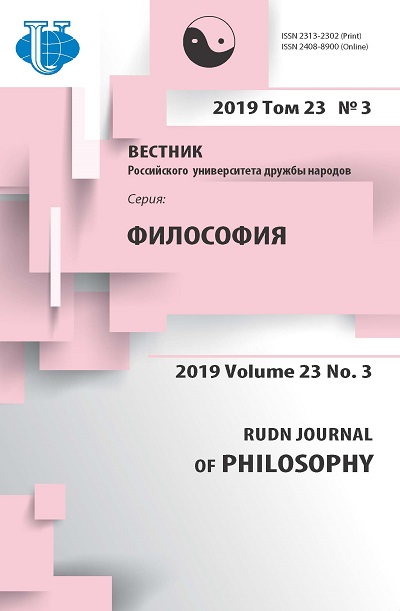CORPOREALITY AND THE SELF: DISSOLVING BORDERS WITH TECHNOLOGY
- Authors: Selchenok AK1, Berest VA2,3
-
Affiliations:
- Moscow Pedagogical State University (MPGU)
- National Centre for Contemporary Arts (NCCA)
- Peoples’ Friendship University of Russia (RUDN University)
- Issue: Vol 23, No 3 (2019)
- Pages: 302-311
- Section: MORAL DILEMMAS IN THE ERA OF HIGH-TECH SOCIETY
- URL: https://journals.rudn.ru/philosophy/article/view/21937
- DOI: https://doi.org/10.22363/2313-2302-2019-23-3-302-311
Cite item
Full Text
Abstract
This paper describes the concept of corporeality in the context of science art and the role of technology in contemporary culture. Human corporeality is a body endowed with soul and meaning. It results from personal and social experience, historical development, or cultural context and its implicit impacts. The subject of this research is corporeal code that organize the nature of modern artistic productions and human being identity. Contemporary artists use the strategies of participation and interaction, forms of interventions to make art an agent of social change and to become active drivers for the new identity process activation. Problems of identity make up a significant layer in contemporary art. The identification process develops in them in various directions. We can characterize its evolution as a change of identities. Recognizing the role and intense impact of technology on contemporary culture, we can trace two main directions: one involves extension of human senses and abilities by creating new solutions, software and tools, that let us get advanced understanding of the reality, and the second one is based on presupposed physical capacities of the human corporeality. According this approach the understanding of reality as a reality given in sensations is disappearing. The virtual world comes to replace it, our essence becomes involved in the process of mixing and indistinguishability until its complete disappearance.
Keywords
About the authors
A K Selchenok
Moscow Pedagogical State University (MPGU)
Author for correspondence.
Email: anastasiya.selchenok@gmail.com
кандидат социологических наук, доцент кафедры культурологии института социально-гуманитарного образования
Moscow, RussiaV A Berest
National Centre for Contemporary Arts (NCCA); Peoples’ Friendship University of Russia (RUDN University)
Email: berest-va@rudn.ru
научный сотрудник отдела хранения Государственного центра современного искусства, старший преподаватель кафедры теории и истории культуры факультета гуманитарных и социальных наук Российского университета дружбы народов
Moscow, RussiaReferences
- Descartes R. The Philosophical Writings of Descartes, vols. I & II, trans. and ed. John Cottingham, Robert Stoothoff, and Dugald Murdoch. Cambridge: Cambridge University Press; 1984-1985.
- Deleuze G. Guattari F. Anti-Oedipus: Capitalism and Schizophrenia. Penguin Classics, 2009.
- Gromala D, Sharir Y. Dancing with the Virtual Dervish: Virtual Bodies. Arts et electroniques. Numéro 63, Automne, 1995.
- The Uncanny Valley: The Original Essay by Masahiro Mori. URL: https://spectrum.ieee.org/ automaton/robotics/humanoids/the-uncanny-valley (accessed February 2019).
- Gomez-Pena G. Dangerous Border Crossers. New York: Routledge; 2000.
- Leanos JJ. Projects. URL: http://www.leanos.net/projects/los_cybrids/index.html (accessed March 2019).
- Moura L; Pereira HG. Symbiotic Art: Man and robots. Create Space Independent Publishing Platform, 2014.
- Berdyaev N. Man and Machine. Bourgeois Mind and Other Essays. The bourgeois mind and other Studies in Modern Life. London: Sheed and Ward; 1934.
- Berest V.А. Conceptual artwork as a polycode text. Polylinguality and Transcultural Practices. 2016;(3):124-129.
- Probings: An Interview with Stelarc. Interview by Joanna Zylinska and Gary Hall. URL: http://www.joannazylinska.net/probings-interview-with-stelar/ (accessed March 2019).
- Katherine NH. How We Became Posthuman: Virtual Bodies in Cybernetics, Literature and Informatics. Chicago: University of Chicago Press, 1999.
- The Playboy Interview: Marshall McLuhan. Playboy Magazine, March, 1969. URL: https://web.cs.ucdavis.edu/~rogaway/classes/188/spring07/mcluhan.pdf (accessed February 2019).
- Haraway DJ. Simians, cyborgs, and women: the reinvention of nature. New York: Routledge, 1991.
- Le Breton D. La sociologie du corps. Jouve, Paris, 2010.
















